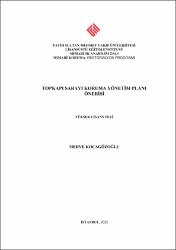Topkapı Sarayı Koruma Yönetim Planı Önerisi
Citation
KOCAGÖZOĞLU, Merve, Topkapı Sarayı Koruma Yönetim Planı Önerisi, Fatih Sultan Mehmet Vakıf Üniversitesi Lisansüstü Eğitim Enstitüsü Mimarlık Anabilim Dalı Mimari Koruma- Restorasyon Programı,Yayımlanmamış Yüksek Lisans Tezi, İstanbul 2022.Abstract
İstanbul Tarihi Yarımada’da konumlanan Topkapı Sarayı’nın inşaası, 1454 yılında Fatih Sultan Mehmed tarafından başlatılmıştır. Diğer padişahlar tarafından farklı dönemlerde yapılan eklentileriyle yatayda asimetrik mimari olarak gelişmiştir. Özgün bir devlet yönetimini yansıtan Topkapı Sarayı, eserleri ile günümüze kadar ulaşmış önemli bir mirastır.
Sur-i Sultani’nin de içinde olduğu İstanbul Tarihi Yarımada Yönetim Planının ilki 28 Ekim 2011 tarihinde yapılmıştır ve Sur-i Sultani’yi de kapsamaktadır. ICOMOS’un tavsiyelerinin de dikkate alındığı güncellenen Mayıs 2018 tarihli İstanbul Tarihi Yarımada Yönetim Planı çalışması hazırlanmıştır; fakat UNESCO’nun Dünya Mirası Listesi ön koşulu olan yapı ölçeğinde hazırlanmış Koruma Yönetim Planlarına ihtiyaç vardır. Bu bağlamda antik çağlardan beri cazip bir yönetim ve yerleşim alanında konumlanmış ve diğer tarihi yapılara da koruma anlamında öncülük eder nitelikte olan Topkapı Sarayı ve çevresinin hem ulusal hem de uluslararası alanda kültürel bir miras olarak korunması, sürdürülebilir ve bütünleşik koruma politikaları kapsamında yer alması için gerekli uluslararası prosedürlerle desteklenmesi ve tanıtılması adına Topkapı Sarayı Koruma Yönetim Planı Çalışması tez kapsamında ele alınmıştır.
Tez çalışmasının ilk bölümünde, koruma yönetiminin dünyadaki gelişimi ve Türkiye’deki alan yönetimi ilkeleri üzerinde durulmuştur. İkinci bölümde ICOMOS, ICCROM ve IUCN ve UNESCO gibi kuruluşların Koruma Yönetim Planı rehberleri incelenerek içerikleri ortaya konulmuştur. Üçüncü bölümde dünyadan UNESCO’nun koruma listesinde yer alan ve farklı karakter alanları ile Topkapı Sarayı yerleşkesi ile benzerlik gösteren İngiltere’den bir örneğe dair Koruma Yönetim Planı incelemesi yapılmıştır. Dördüncü bölümde Topkapı Sarayı’nın süreç içerisindeki gelişimine dair kısa tarihçesi ile karakter alanları, tarihi, kültürel, arkeolojik, eğitim ve sosyal değerlerinin açıklamalarına yer verilerek alan tanıtımı yapılmıştır. Alanın mevcut durumunun güçlü ve zayıf yönleri ile tehditler ve fırsatlar değerlendirilerek Koruma Yönetim Planı önerisi sunulmuştur. Sonuç bölümünde KYP değerledirmesi yapılmıştır.
Çalışmada izlenen yaklaşım ve yöntemlerin Milli Saraylar kapasamındaki yapılar başta olmak üzere, tarihi yapıların korunması için uygun yaklaşımların geliştirilmesine katkı sağlaması amaçlanmıştır. The construction of Topkapi Palace, located in the Istanbul’s Historical Peninsula, started in 1454 with the order Sultan Mehmet The Conqueror. With the additions made by other sultans in different periods, the Topkapı Palace, which has a horizontal asymmetrical architecture and has a unique monarchy structure, is an important heritage that has survived to the present day with its works of art it hosts.
The first of the Istanbul Historic Peninsula Management Plan, which includes Sur-i Sultani, was made on October 28, 2011. An updated version of the Istanbul Historic Peninsula Management Plan which also took into account the recommendations of ICOMOS was prepared in May 2018.
However, there is a need for Conservation Management Plans prepared at the building scale, which is the prerequisite of UNESCO's World Heritage List. In this context, it is necessary to protect Topkapı Palace and its surroundings, which has been located in an attractive management and settlement area since ancient times and pioneered other historical structures in terms of protection. I wanted to analyze Topkapı Palace Conservation Management Plan to contribute to the efforts for this palace to be considered a cultural heritage both nationally and internationally, and included in the scope of sustainable and integrated conservation policies and to be supported and promoted with international procedures.
The studies carried out within the scope of this thesis are evaluated in five sections. In the first chapter, the aim, scope and method of the thesis are discussed. In the second part of the study, the development of the conservation management plan in the world and the elements of field management in Turkey are emphasized. In the third chapter, guidebooks for the Conservation Management Plan of variıus institutions such as ICOMOS, ICCROM and IUCN and UNESCO are examined and their contents are revealed. In the fourth chapter, a Conservation Management Plan review was made for a similar structure in England, which is on the UNESCO's list of protected heritage.
In the fifth chapter, the brief history of Topkapi Palace's development in the process and the descriptions of its character areas, historical, cultural, archaeological, educational and social values were given and the site was introduced. A Conservation Management Plan proposal was presented by evaluating the strengths and weaknesses of the current situation of the area, as well as threats and opportunities.
The approach and methods followed in the study aim to be a framework that will contribute to the development of appropriate approaches for the preservation of historical buildings, especially those within the scope of National Palaces.



















